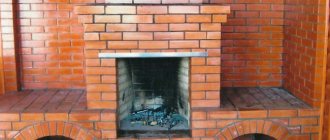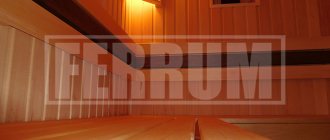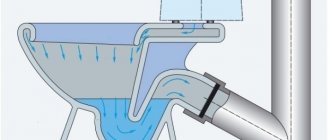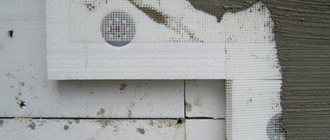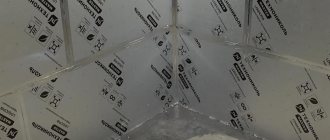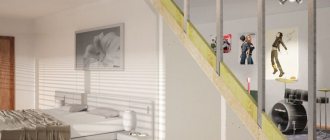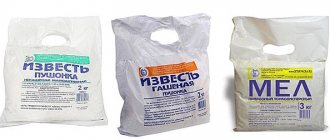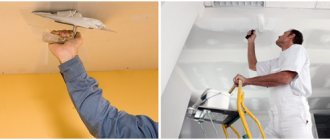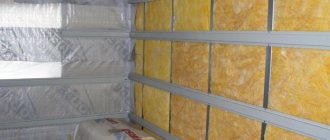Concrete is considered a convenient and simple material from which various residential and permanent structures are built. But how to insulate concrete walls from the inside? Concrete has high-quality characteristics, which makes it in demand in the construction market. Despite all its advantages, the composition also has disadvantages: the material conducts heat, which requires additional insulation of the structure.
Insulation instructions
Regardless of the materials used for thermal insulation of the apartment, it is important to take into account a number of rules and nuances:
You can start insulation work only during the warm period, when it is dry outside. Before fixing the insulation, you need to dry the surface
For such purposes, the use of a heater is allowed. Next, you need to completely clean the structure, paying special attention to places where moisture and fungus accumulate. Treat with an antiseptic and apply a layer of primer. Before each subsequent stage, you need to wait until the previous layer has dried.
Expanded polystyrene
The material is popular due to its availability and ease of gluing yourself.
To apply insulation you need to follow these instructions:
- Apply adhesive backing to the back of the tile. It is advisable to do this pointwise, maintaining intervals of 30-35 cm.
- When gluing products, do not allow the seams in the rows to coincide.
- Next, apply fiberglass mesh and an additional layer of glue.
- A steel profile is used to strengthen the corners.
In addition to glue, disc-type dowels are used as fixing elements. The reinforcement mesh should have cells of 3-5 mm and an overlap of 10 to 12 cm. If the building was built according to the old plan, the insulating layer should be 8 cm thick.
Polyurethane foam
Surface treatment with polyurethane foam has the following advantages:
- The material does not require the additional use of plaster or other protective compounds, since it is not afraid of the influence of ultraviolet rays and mechanical stress. This helps to extend the service life.
- During operation, polyurethane foam does not lose its presentable appearance and competently masks all defects in the walls.
- A technical endoscope is used to check the quality of the pouring.
- Using polyurethane foam you can insulate various structures with a hollow structure.
Mineral wool
The technology for installing the slabs involves fixing a special metal or wooden frame, as well as following the following instructions:
- The installation is carried out in 2 stages: in the first, the space between the frame and the surface is filled, and in the second, the gaps in the frame are filled.
- Products made from polyurethane foam must have a thickness of 50 mm and a density of 75 kg/m³.
- After completing the fixation of the slabs, it is necessary to fix the vapor barrier film.
- The film is fixed with an overlap on the edges of the slabs.
- The points to which the film adheres are treated with sealant.
- Finally, drywall is attached and finishing work is carried out.
Thermal insulating plaster
Often the insulation layer is made on the basis of heat-insulating plaster. To maintain evenness of application, special indicators are used.
The fixation process is carried out in 3 stages:
- Spray - the first layer is 10 mm thick. It is a liquid consistency for covering cracks and irregularities.
- The primer is a key part of the 45-60mm thick thermal insulation.
- The finishing coating is 5 mm thick and is a combination of chalk powder with water to properly mask defects.
Other materials for insulation
In addition to the materials listed, other solutions are used to insulate facades. This can be siding insulation, thermal panels, penofol or foam glass.
Thermal panels
Such products are particularly easy to apply, since the sheet is fixed to the surface only with glue.
Foam glass with fiberglass coating
Most boards based on this innovative raw material have a density of 100-150 kg/m³. To fix them, glue and dowels are used. Drywall is fixed on top of the slabs or a finishing layer of plaster is applied.
Penofol
The insulation is characterized by high resistance to steam penetration, and with a thickness of 10 mm, it has the same thermal insulation properties as 3 cm of mineral wool. However, for more effective heat conservation, penofol is applied in several layers.
In most cases it is used as an auxiliary material.
Features and differences of thermal insulation from the outside of the building and from the inside
Each option for installing thermal protection for a building - external or internal - has its own nuances in execution.
The main differences are in the environment:
- when installed externally, this is a strong influence of the atmosphere with sudden temperature changes and wind loads;
- with internal protection it is a more uniform air environment with average annual temperatures of 18-25 C.
The next difference between the two options is the thickness of the protective layer:
- for outdoor work it is higher than 100 mm;
- for internal ones - does not exceed 50 mm.
And the last significant difference is the formation of the dew point:
- With external insulation, it is brought out onto the outer surface of the wall.
- If it’s internal, it’s on a surface that opens into the room, which is very dangerous, since condensation can accumulate on the wall. It will not only spoil the external decoration of the house, but also penetrate into the structure of the base and foundation, causing their destruction.
Tips and tricks from experts
One of the key difficulties of insulating a room from the inside is that the insulated wall does not become warmer, on the contrary, it begins to cool even more. In this state of affairs, the dew point shifts closer to the inner section of the wall. Condensation appears, leading to an increase in humidity, and the wall itself and the finishing layers suffer from this. The insulating characteristics of the insulation are significantly reduced. In fact, the level of heat loss remains the same, but increased humidity is formed. Brick surfaces suffer especially greatly from such exposure.
Fortunately, this problem is solvable. One has only to choose a heat insulator with a reduced level of moisture absorption and vapor permeability. The structure of such insulation should not contain fibers. During installation, avoid the formation of joints or gaps that will allow condensation to enter the room and air to penetrate into the interlayer space.
The following types of insulating materials do not meet the above criteria:
- warm plaster;
- cork covering;
- liquid ceramics;
- drywall;
- mineral wool.
GKL and plaster can only be used at the final stage of thermal insulation of the room.
This type of material such as penoplex or expanded polystyrene also does not cause delight among experienced builders. This is due to the fact that this slab material is difficult to perfectly join. If you do not use special adhesive solutions, it will not attach well to the wall. As a result, the level of tightness decreases, which leads to the difficulties described above.
Why is it necessary to insulate?
According to modern requirements, single-layer insulation is practically not performed. The composition of the heat-protective cake is determined by:
- installation location: outdoor/external;
- characteristics of the wall;
- the type of insulation chosen.
If you ask a professional how it is preferable to insulate the walls of a residential building, from the outside or from the inside, the answer will be unequivocal - from the outside.
Internal thermal insulation is installed only as a last resort, when there is no other possibility, for example, the building is an architectural monument or the small distance between adjacent walls does not technologically allow the installation of insulation.
The installation of internal insulation must be treated with great care, this is primarily due to the occurrence of a dew point at which condensation begins to flow along the wall, and in addition, the insulated wall is no longer protected by heat from the in-house heating system, since the heat barrier will not be able to transmit heat to it .
External insulation protects at cold temperatures, and to prevent household moisture from getting on the thermal insulation material , waterproofing is installed, in this case the dew point moves much further from the room to the street.
To prevent water from collecting between the wall and the heat insulator, a vapor barrier will need to be installed. Innovative heat-protective building materials are produced with a pre-installed vapor barrier layer.
In cases where the heat insulator is applied to the outside of wall structures, a wind barrier made of a vapor-proof membrane must be installed on top. It fences off the heat insulator from cold air masses hitting it.
Many novice craftsmen believe that there is no such thing as excess thermal insulation; this is not entirely correct. In thermal protection of buildings, the term used is excessive or excessive insulation.
A thick layer of insulation can disrupt the ventilation system of building structures . In connection with this, condensation will begin to accumulate, increasing the humidity in the room, which contributes to the occurrence of rotting processes and the formation of mold.
Features of internal wall insulation
Comparison of wall blocks by thermal insulation properties.
Usually, major insulation of walls from the inside is carried out out of urgent need, because external insulation is impossible. Internal insulation has a number of specific disadvantages that must be taken into account when choosing an insulation method. First of all, applying wall coatings changes the overall indoor climate. Creating an insulating layer does not allow the wall to “breathe,” which increases moisture condensation and requires additional ventilation of the room. Inside the wall, due to changes in heat exchange conditions and moisture transfer, moisture accumulates, which can lead to the formation of fungi and mold. These phenomena can reduce the load-bearing capacity of the wall.
Additional thermal insulation enhances the effect of internal drafts in the room. Finally, internal wall cladding reduces the usable area of the room. In addition, changes in wall design must be taken into account when creating the overall design of the room. The specific conditions that arise when insulating a concrete wall from the inside dictate the basic technical requirements. The internal coating of the wall should be a good heat insulator and create a reliable vapor barrier, provided that the room is well ventilated.
Insulation by spraying polymer
The most effective, but much more difficult, is to insulate walls by spraying polyurethane foam. To do this, the wall surface is prepared similarly to other insulation methods. For spraying, a special two-component mixture is used. Polyurethane foam is applied to the surface using a spray gun. The liquid solution, falling on the surface of the wall, hardens within a few seconds. As a result, a dense layer is formed with good thermal and waterproofing properties. Spraying is carried out evenly over the entire surface of the wall.
Return to contents
Thermal insulation plaster
The secret of heat-insulating plaster lies in polystyrene foam bubbles with air, they create thermal insulation. Plaster must be applied to a prepared base; this is the simplest and most common method of fastening. The product is expensive and in demand; it is best to purchase plaster in specialized stores; purchasing it on the market risks purchasing a fake. You should check the documentation and certificate of conformity to be sure of the effectiveness of the composition when used.
Technologies for carrying out insulation work come in two options: external and internal methods. The main technological procedures are:
- Wet method - gluing sheets to a pre-prepared base with special glue, followed by plastering. Plus – the simplicity of the installation process itself.
- The dry method (frame) is more complex; hiring professionals is the most appropriate solution.
External treatment of the facade is much more effective, but for a number of reasons, internal thermal insulation is often carried out. In any case, comfort and coziness in the living space is ensured.
Cost of work
Table with approximate prices:
| Thermal insulation grade | Size | Material price, rub. | Cost of work, rub. Moscow | Cost of work, rub. Yaroslavl | Cost of work, rub. Voronezh |
| Akterm Concrete | 20 l | 7000 | 350 m2 | 200 m2 | 230 m2 |
| Polyurethane foam spraying method | Packaging, 4 m3 | 5300 | 900 m3 | 790 m3 | 800 m3 |
| Basalt mineral wool GREENGUARG | 0.288 m3 | 510 | 300 m2 | 250 m2 | 270 m2 |
| Insulation: Expanded polystyrene boards. extrusion TECHNONICOL | 0.273 m3 | 1356 | 500 m2 | 350 m2 | 300 m2 |
| Penoplex Facade, glue, doweling | 1185 mm x 585 mm x 50 mm, pack of 4 pieces | 1370 | 600 m2 | 450 m2 | 430 m2 |
What materials and tools need to be purchased?
Tools for installing thermal insulation.
- Thermal insulation in the form of sheets, slabs or liquid.
- Deep penetration primer composition.
- Antiseptic.
- Sealant or mastic.
- Special plaster mixture for bathrooms or swimming pools.
- Metal construction mesh.
- Wooden slats.
- Brick or plasterboard sheets.
- Waterproofing materials.
- Vapor-proof film.
- Metal profile for installing drywall.
- Drill with mixer attachment.
- Needle roller.
- Rule.
- Plastic beacons.
- Spatula-comb.
- Building level.
- Screws, dowels, plates for suspension.
To insulate concrete walls, you can use different materials and methods of installation. It all depends on the financial capabilities of the apartment owner. Desire alone is not enough in this matter. It is best to insulate walls in summer, when it is hot. Then you won’t need to dry them using heaters. When work is completed, the owner of the premises must be prepared for the fact that the area of his apartment will decrease somewhat, but in winter the desired temperature will be maintained in it.
At the same time, our floors are quite warm; there is no cold coming from below. So it's the walls?
Tell me, maybe there are other ways to insulate concrete walls. Tired of freezing and paying large sums for heating. It's better to spend this money on repairs.
I will be very grateful for the answer. Irina.
Your problem is quite clear and can be explained simply: you did almost everything wrong. Namely: they insulated from the wrong side, choosing the wrong thermal insulation material. Let me explain.
What can be used as thermal insulation
There are many similar materials, namely:
Scheme of insulating a concrete wall with polystyrene foam.
- Expanded polystyrene or polyurethane.
- Styrofoam.
- Plaster.
- Drywall.
- ICE or fiberboard panels.
- PVC panels.
Let's consider ways to use them for wall insulation.
The easiest and cheapest way is to apply a layer of additional plaster. To perform such work, you will need a metal construction mesh. The walls are first primed and a liquid primer is “sprayed” on them to strengthen them.
This is also done after laying each layer of plaster, which is applied evenly and has a thickness of up to 5 mm. There should be 4-5 such layers, and they cover all the walls of the apartment. Before starting work, the old plaster must be removed and the rooms must be vapor-proofed. It can be made of roofing felt, bitumen mastic, waterproofing material, etc.
Preparing mortar and applying plaster to a concrete wall.
When using plasterboard slabs, the lathing is first made from metal profiles. Then thermal insulation made of felt, mineral wool or polystyrene is installed in the resulting cells and covered with sheets of plasterboard.
When using PVC, ICE or fiberboard panels to insulate walls, you need to make a frame from slats. A vapor barrier and thermal insulation material are installed inside it.
Styrofoam can be directly glued to the wall, but this “cheap” option does not always produce positive results.
The most reliable way is to use polyurethane for wall insulation. It is able to create a good moisture-resistant barrier and has excellent thermal insulation properties.
The difficulty is that at the first stage it is a foamed liquid and hardens very quickly. To create an even layer of thermal insulation, you need to use formwork, all the voids in which are gradually filled with polyurethane.
Scheme of insulating a concrete wall from the inside with polyurethane foam.
After this, vapor protection and waterproofing are installed. It is made of polyethylene film, which must be secured to adjacent walls, floor and ceiling. This is done using slats and sealant. Since polyurethane has relatively low mechanical strength and low density, an additional wall of plasterboard is made from inside the apartment. This is a very effective thermal protection, but, compared to other types, it requires additional financial costs.
If you use polystyrene, you need to pay attention to its installation. This material consists of sheets measuring 100 x 100 cm, so many joints are formed
The sheets must be adjusted, and a layer of sealant must be applied to their ends. When insulating walls from the inside of a room, air chambers may appear, in which fungi and mold or condensation will appear over time. To secure the sheets, apply glue evenly over the entire surface. Before this, the material is perforated with a needle roller, which helps the adhesive composition to better adhere to the sheets.
In any case, you must first level the walls. To do this, you need to purchase special mixtures that can form a layer of waterproofing.
Tips and tricks from experts
One of the key difficulties of insulating a room from the inside is that the insulated wall does not become warmer, on the contrary, it begins to cool even more. In this state of affairs, the dew point shifts closer to the inner section of the wall. Condensation appears, leading to an increase in humidity, and the wall itself and the finishing layers suffer from this. The insulating characteristics of the insulation are significantly reduced. In fact, the level of heat loss remains the same, but increased humidity is formed. Brick surfaces suffer especially greatly from such exposure.
The following types of insulating materials do not meet the above criteria:
- warm plaster;
- cork covering;
- liquid ceramics;
- drywall;
- mineral wool.
Insulating an apartment with mineral wool
With this technique, the walls do not require special preparation; they do not even need to be plastered. Wooden or metal slats are immediately attached to the surface. The height of the slats must correspond to the thickness of the heat insulator; the distance between them is taken as the width of the roll (mat) minus 2 cm to ensure that the material fits tightly into the frame.
A vapor barrier film is laid on top of the slats; it can be attached to the wall using “liquid nails.” Next, mineral wool is laid, on top of which another layer of vapor barrier is made. After which the entire structure is covered with plasterboard, the sheets of which are attached directly to the slats. - a matter of taste of the owners.
Causes of moisture
The first thing you need to figure out is why moisture began to appear on the walls of your home. There may be several reasons for this phenomenon and each of them requires its own solution. Most often, the walls begin to sweat in the following cases:
- There is poor or no ventilation in the room.
- The structures are freezing.
- The waterproofing is broken.
- The room was recently renovated.
The only scenario in which you should not worry and take radical measures would be the case of repairs. When performing various finishing works, mixtures are used that contain water and it actively evaporates. After a certain time this passes and everything becomes normal. If the water appeared for another reason, you will need to urgently take some action.
Even if the reason for the appearance of water is a recent renovation, it is better not to aggravate the situation and ventilate more often. Of course, you should take into account the recommendations of manufacturers of finishing materials and in some cases it is better to avoid ventilation. Then you should ensure the best possible air distribution throughout the entire area of the house - open all doors wide.
Consequences of the lack of protective layers
Thin insulation that does not have important protective layers or excessively thick insulation cause equal damage to a home. In this case, a distinction is made between mechanical and chemical destruction of concrete structures.
The absence of a heat insulator leads to the following mechanical damage:
- temperature changes, freezing/thawing cycles of building structures;
- frequent cycles of drying/wetting walls;
- destruction of concrete under the influence of wind and water.
Chemical damage includes bimetallic corrosion, the action of acid and alkaline vapors in the air, as well as corrosion from stray currents, as a result of which the carbonization process occurs on concrete, when alkalinity around steel embedded parts and reinforcement units is lost.
Thus, the reasons for the destruction of concrete partitions are complex with a number of factors, but most of all they are associated with the appearance of humidity, which contributes to the appearance of dampness in the room and black mold, which is extremely harmful to people, which is one of the strongest allergens.
Preparation
Each building material differs in its reaction to environmental influences. Concrete is no exception. In terms of performance, it is superior to brickwork and wood, but requires good thermal insulation. Before you start insulating concrete walls from the inside with your own hands, you need to take into account the following nuances:
- At high density, the monolith remains a water-permeable material, which negatively affects both the condition of the insulation (if they are not able to withstand moisture) and the walls - in cold seasons, condensation will begin to freeze, triggering deformation processes.
- Before carrying out work, concrete is treated with an antiseptic agent, which will prevent the formation of fungi and mold.
- Thermal insulation should cover the entire facade, and not individual parts of the building.
- The amount of insulation is selected taking into account the thickness of the walls.
From inside or outside?
Having decided on the material for insulating a concrete wall from the outside or arranging thermal insulation in an apartment from the inside, you need to consider the features of each method. Experienced experts recommend putting the main priority on external insulation, since without it, internal insulation will be ineffective and will only aggravate the problem.
Work can begin in warm periods and dry weather. To increase protection against heat loss, the home is covered with insulation on both sides.
Material counting
The consumption of insulating materials depends on a lot of factors. First of all, the evenness of the surface of the wall that will be insulated is taken into account - this indicates the amount of glue for fixing the foam.
Calculations are carried out for smooth walls according to the following principles:
- To glue foam boards onto the “pads” (without an adhesive layer around the edges), you will need to use 5 kg of polystyrene foam glue.
- The dimensions of the slabs must correspond to the parameters of the walls without taking into account openings (windows and doors). The thickness of the material is determined by the region of residence.
- To strengthen the plaster, reinforcement with facade fiberglass mesh is used. The number of reinforced concrete structures is selected taking into account the parameters of the wall.
- If the facade will be covered with decorative plaster, then to level the surfaces you will need to purchase a primer with quartz sand. The consumption of this composition is 300 g/m².
- Before painting structures, they must be treated with a deep penetration primer - 200 g/m².
- The consumption of plaster is determined by the size of its grains.
- The consumption of the coloring composition depends on the application method (spray gun, roller and brush).
Surface preparation
After purchasing materials for wall insulation, you can proceed to surface preparation. To do this, you need to clean them of old paint, mold and dirt, and then cover them with an antiseptic.
This will ensure a dry and smooth surface. If there are cracks or chips, they need to be covered with plaster. The composition must also be used to level surfaces.
In the upper part, the wall is coated with a primer, which will increase the adhesion of the material to the adhesive base.
How to insulate the inside of a wall with your own hands using roll insulation
The most common type of insulation is roll insulation. DIY installation technique:
- The surface of the wall needs to be prepared: cleaned of old coating, sanded down uneven areas and cracks.
- Prime and wait until completely dry. Sometimes the procedure needs to be repeated if the wall has large roughnesses.
- Then measure out the required amount of roll insulation, be sure to leave a small gap. Cut into equal pieces.
- Prepare the adhesive solution strictly according to the instructions. Some types of Polyfom are self-adhesive.
- Next, you need to glue the insulation, almost the same as wallpaper. It is important to smooth out and eliminate air bubbles.
- The last step is to seal all joints with masking tape.
After completing the work, you need to wait some time, usually from one to three days. This is indicated in the instructions. Further finishing can then be done.
When installing insulation, there should be no drafts in the apartment, the permissible humidity should not exceed 50%.
When renovating an apartment, you should definitely pay attention to the issue of heat conservation. Modern materials have great functionality, the main thing is to choose the right one and consult with specialists. The most popular are roll and cork insulation. Following the advice, the material is easy to install yourself.
Use of polystyrene foam
Insulating a concrete wall from the outside with polystyrene foam is economical and practical; reducing heat loss will reduce financial costs, regardless of the type of heating. The use of the material has a beneficial effect on optimizing the microclimate in the house. It feels warm in winter, pleasantly cool in summer. How to insulate a cold loggia wall, the answer is obvious - this material is perfect for arranging thermal insulation for a small space. The advantages of slabs are multifaceted:
- the functional area remains dry, without the appearance of fungus and mold;
- the product has soundproofing properties;
- the material is moisture-resistant and does not lose its characteristics when wet;
- due to its minimal weight, massive metal fastenings are not needed;
- minimal load on the foundation;
- external installation of thermal insulation does not reduce space;
- After installation, the sheets can be painted in the desired color, transforming the facade.
The fastening technology is suitable for cottages and apartments in high-rise buildings. To install sheets at height, it is better to involve industrial climbers, this will help avoid investing in special equipment or installing façade formwork.
Installation
There are different methods for installing insulation. When choosing a suitable option, you need to take into account the complexity of its implementation and financial capabilities.
Insulation
To attach the polystyrene foam sheet, an adhesive mixture of Ceresit and dowels are used. First of all, you need to dilute the adhesive base with water to obtain a uniform consistency. The quality of this mixture determines the reliability of fixation of the material.
Having completed the preparation of the glue, you can begin to apply it evenly to each sheet of polystyrene foam or PSB foam. 10-20 cm are left between portions, and 5-10 cm between the edges of the material. Particular attention should be paid to the central part of the insulation.
After applying the glue, proceed to fixing the material. The sheets are glued from the bottom corners. It may take 2 to 4 days for the mixture to dry. To improve the strength properties of the structure, dowels are driven into the wall. The formed joints are treated with plaster or construction foam.
Mesh and rough finish
After making sure that the adhesive base has completely dried, you can proceed to the next stage - fixing the reinforced mesh using the same Ceresit glue.
The base must be evenly distributed over the slab, pressing the mesh with reinforcement on top, moving from the upper parts to the lower ones. After this, another layer of glue, putty and primer are applied. At the last stage, siding panels are installed.
Insulation instructions
If you don’t take into account the option of using polyurethane foam, then all the work is done yourself
It is important to familiarize yourself with some nuances and begin the task:
Insulation of concrete walls is carried out in dry weather, at temperatures from +5 to +30 degrees. The wall is well dried, not damp. It is important to clean the surface, remove all excess, seal cracks and level it. Mold, mildew, and greasy stains are removed... At the end, all that remains is to treat the concrete with an antiseptic and get to work
At the end, all that remains is to treat the concrete with an antiseptic and get to work.
Using polystyrene foam
The advantages of polystyrene foam are considered, as is the technology for creating a wet facade. But, there is a second option - frame. Sequence of work:
- The sheathing is placed on the surface.
- The distance between the slats is identical to the width of the foam sheet.
- Insulation is installed in the created cells.
- Everything is covered with lathing and the structure is finished with finishing panels: block house, lining, siding.
For insulation in cold regions, the layer thickness is from 10 to 20 cm.
Using mineral wool
Mineral wool is an excellent material with excellent characteristics. However, she is afraid of moisture. Therefore, when thermally insulating concrete, it is necessary to create a ventilation gap so that the wool dries. Here we need the frame technology described above.
Features of the work: after creating the sheathing, mats or rolls of mineral wool are installed
It is important to lay them tightly, without forming joints. To do this, the distance between the slats is made 5–10 mm less than the width of the wool
All that remains is to fix the vapor barrier, glue the joints and sheathe the frame with the selected material. An apartment can be insulated with mineral wool both from the outside and from the inside.
Using thermal panels
Thermal panels are a multilayer material. It is made of insulation and decorative material. The manufacturer has simplified the task; a concrete house can be insulated with such panels, and not have to think about additional finishing. Typically used for exterior decoration. Installation is simple - just apply glue to the surface and fix it on the wall.
Using foam glass and fiberglass
Foam glass is an insulating material in the form of slabs, the density of which is from 100 to 150 kk/m3. Such insulation is fixed to the wall using glue. The structure can be strengthened with dowels, as is the case with polystyrene foam. The finishing layer is different, ordinary plaster, drywall or decorative panels.
The peculiarity of the material is that it is not afraid of moisture, is environmentally friendly, and is not damaged by rodents. Cutting mats is quite simple. The surface can be strengthened and secured with reinforcing mesh and corners. The disadvantage of such insulation for concrete is that it has a high cost.
Using penofol
This is foil insulation. It is environmentally friendly, efficient and practical. The thickness is small, which allows you to quickly fix it on the wall. The layer is vapor-proof. However, penofol is not suitable as the only insulation material. It is better to combine it with other heat insulators or use it as a heat-reflecting layer and vapor barrier material. Installation is carried out on the wall or on the lathing.
Before insulating concrete walls, it is important to think through the sequence of work in advance, choose what to insulate the structure with, comparing all the pros and cons, and then get to work. But, if you are unsure of your abilities, it is better to overpay, but entrust the work to specialists who will do it efficiently and without errors
Option for insulating a balcony from the inside
In the case of a loggia and a balcony, the situation is often completely different. If the authorities do not allow the installation of a wall, they require that the existing reinforced concrete screen be left; it is cut off from the warm air by careful thermal insulation made of extruded polystyrene foam (EPS).
Insulation of the balcony from the inside
In this case, it is better to make the insulation excessive than at least slightly insufficient. The total thickness is divided into two layers. They are laid without a gap (preferably with locks), and so that the seams of the first layer overlap the sheet of the second. There should be no through access of warm air to the screen.
It is necessary to approach very carefully the issue of insulating the floor and ceiling of the loggia/balcony, ensuring tightness at the junction of them with the walls
Also pay attention to how the glazing will be installed: there may also be problem areas: the joint with the screen, walls, insulation of the part above the frames. All of them must be well finished, excluding the possibility of contact of warm/cold air
In this case there will be no problems. Even if the balcony is combined with the room.
Basic methods
Modern manufacturers delight customers with a wide range of various thermal insulation materials that meet the basic quality parameters of these products.
However, experts with sufficient experience in the construction industry give advice on how to insulate a concrete wall in an apartment using only three main methods, which are considered the best:
- Insulation using foam plastic,
- Insulation with mineral wool,
- Insulation using a warm plaster solution.
Application of foam plastic
Today, foam plastic is considered a popular insulation material (for example, Penoflex insulation). It is lightweight, easy to use and low price make it the most common insulation material.
Insulation of premises from the inside with polystyrene foam
This method of thermal insulation is both the simplest and cheapest:
- Carefully plaster the concrete wall.
- Let the solution dry completely.
- We begin to level the surface by applying one layer of putty.
- Upon completion of puttying, we lay waterproofing material around the entire perimeter.
- Next we move on to installing the insulating layer:
- we treat the walls with special glue,
- We lay the sheets of foam plastic end-to-end, one to the other, avoiding the formation of cavities between them.
Method of internal insulation with foam plastic
- We complete this stage of work by installing the vapor barrier material on the foam layer.
Application of mineral wool
The second method of insulating concrete walls and increasing their thermal insulation capabilities is more difficult to implement. In addition, insulation with mineral wool can only be done if there are wooden slats. Lath lathing “steals” some space in the room due to its thickness, so it is difficult to use if you want to insulate a loggia. Therefore, thermal insulation experts advise against plastering walls if this technique is used. However, no consensus has been found on this issue.
Photo of insulation with mineral wool
The following are instructions for insulating walls with mineral wool:
- we install wooden slats vertically on the walls, using a level for accuracy,
- we fill the distance between them with waterproofing material, fixing it directly to these slats.
- We proceed to laying the insulating material on top of the waterproofing material. Monitor the density of the insulation in the space between the slats. There should be no gaps between the slabs of material and the wooden slats. To do this, the distance between the slats is made less than the width of the insulation material.
Laying without gaps between slabs and slats
Application of plaster solution
The use of a plaster layer as a thermal insulation material is not a new technology. However, even today it remains quite popular. However, one should not think that this method of thermal insulation is too simple. It also has its own characteristics, including a three-layer plaster layer.
So, how does insulation work using plaster:
- Applying the initial layer with your own hands is carried out by uniformly spraying the surface with a liquid plaster solution. This is done so that the solution penetrates as deeply as possible into the walls having microscopic cracks.
- The second layer, 50-60 mm thick, is soil. Moreover, it is applied not in one, but in 2-3 layers. This takes time and patience.
How to apply plaster
How to choose insulation: tips
In order for the thermal insulation material to meet the stated requirements, it is necessary to choose the right type, taking into account the condition of the walls and the type of wallpaper. Recommendations:
- Roll-type insulation has additional functions: it levels the surface, has sound-proofing and vapor barrier properties, and wallpaper can be glued to it several times;
- when purchasing, read reviews about the manufacturer and the technical qualities of the product;
- consult with the seller before choosing, check the characteristics of the material;
- Cork insulation costs on average from 900 to 6 thousand rubles, while roll insulation costs around 900-1000 rubles per piece. Prices vary depending on the company.
High-quality Polyfom is elastic, does not tear and has no odor. If the material does not have these characteristics, then this indicates poor quality.
Functional purpose of wall insulation under wallpaper
In the last century, old newspapers acted as insulation under wallpaper. Several layers of newspaper served as some thermal insulation and at the same time leveled the surface of the wall. The gluing technology differed in the duration of the operations - after all, each layer had to dry.
The main purpose of thermal insulation applied from the inside of the walls of a house under wallpaper is to insulate the wall. In addition, the coating performs the following functions:
- improvement of the indoor microclimate, temperature increases by an average of 1-2°C;
- preventing water condensation on the surface of the wallpaper, causing mold and mildew;
- reduction of space heating costs;
- additional leveling of walls before wallpapering;
Thermal insulation under wallpaper does not require the use of complex technologies or expensive equipment; the owner of the house can easily do all the work with his own hands. Installation of roll or cork insulation is similar to the process of wallpapering itself.
Functions
The substrate consists of several layers. In the middle, as a rule, there is foamed polyethylene, enclosed between layers of paper.
Many multi-apartment “anthills”, both old and new, do not have good sound insulation. Residents hear other people's conversations, and not only in raised voices, but also music and harsh sounds from their neighbors. All this is unnerving and does not allow you to live in peace. Sound insulation is ensured by using a wallpaper backing. This material also allows you to overcome the problem of indoor humidity.
It is an excellent lining for any wallpaper. Using it, the outer decorative layer is easier to glue and it will look better on the walls.
As a result, the finish will last longer and the problem of new repairs, as well as the material costs associated with it, will be postponed. Once upon a time, old newspapers were used as a backing. It was easier to glue wallpaper on them. Technology has come very far since then. Taking into account all the possibilities of modern substrates, their use cannot be considered a whim.
Advantages and disadvantages
Insulation under wallpaper plays an important role in the thermal insulation of an apartment or house.
The undeniable advantages of thermal insulation of walls are as follows:
- creating a comfortable microclimate in the room, the outer wall stops working as a refrigerator;
- preventing moisture condensation on a cold wall, the occurrence of mold and mildew, making the room unsuitable for permanent residence;
- significant savings on heating.
Installing wall insulation under wallpaper has many advantages.
The technology also has some disadvantages:
- extension of finishing time;
- additional costs, for a number of materials, are very significant;
- Some insulation materials have a low density; wallpaper becomes vulnerable to damage from hard objects.
Overall, the advantages outweigh the disadvantages. Insulation under wallpaper, especially for exterior walls, is becoming a common element of interior decoration projects.
Criterias of choice
How to choose the best material for internal insulation of a room? Experts do not give a definite answer. When selecting insulation, you need to consider the following parameters
- Labor costs for preparatory operations and in the sticker process itself. If this factor is decisive, roll materials laminated with a paper layer on both sides win.
- Vapor permeability. The only truly breathable materials that remove moisture are plaster and pressed cork. All others do not allow moisture to pass through. If the application technology is followed, mold and mildew will not form under the coating. In rooms with high humidity, you should not use insulation that absorbs moisture.
- Eco-friendly and allergenic. The only material that does not cause irritation to allergy sufferers is cork. It is also the most environmentally friendly, as it is made entirely from natural materials.
- The owner has construction skills. For those without practical experience in plastering work, it is better not to take on warm plaster and make do with roll materials.
And finally, cost is a fairly important factor. Here it is necessary to take into account the cost of not only the heat insulator itself, but also adhesives, primers, etc. For a number of insulation materials, such as cork, they are quite high.
How to properly insulate concrete walls
Concrete is the main building material. It is found everywhere and has many positive characteristics. But its thermal conductivity coefficient is high, so the material is cold. Heat escapes through the walls, so a lot of money is spent on heating. The only option is to insulate concrete walls. There are many materials for this purpose, and the work itself can be done with your own hands.
How to glue correctly
Practice shows that wallpaper backing adheres remarkably well to concrete, wood, plywood, and drywall. In order to firmly glue it to the surface, you need to prepare the walls themselves for this: tear off the old wallpaper, remove any remaining paint, level out the depressions and seal the cracks with putty or cement mortar. Then you need to prime the surface. PVA glue or some other similar composition will do for this.
The backing strips themselves must be prepared for sticking to the walls in advance. They cut very easily. They must be divided into sheets taking into account the height of the walls and these sheets must be allowed to align.
Smooth sheets of material are coated on the inside with PVA glue or glue that is used for heavy wallpaper or under polystyrene. If there is a high level of humidity in the room, use baguette glue or liquid nails. (This, of course, will be more expensive, but you can be sure of the quality of the repair).
Taking all this into account, you need to act so that the glue does not get on the joints. Otherwise, the pieces of the backing will stick together and the seam between them will be uneven. The canvases with the applied glue are left for five to ten minutes, and then they are glued to the walls joint to joint - just like most modern wallpaper. In this case, the wall must also be coated with the same glue before this. Note that if the outer layer of the backing is non-woven and not paper, then only the wall itself needs to be coated with glue.
The gaps between the canvases must be sealed with paper tape or paper tape. To ensure that the result does not disappoint, just as in the case of wallpapering, drafts should be avoided. Experienced people advise carrying out the work itself at temperatures above +10 degrees and humidity less than 70 percent. If the room is cold, the glue will not set, but if, on the contrary, it is too hot, it will dry very quickly, and you may not have time to fix the entire substrate on the wall. Some areas will not be glued. Taking these features into account, it is recommended not to undertake such repairs in the spring or autumn, when there is high humidity and strong temperature changes.
